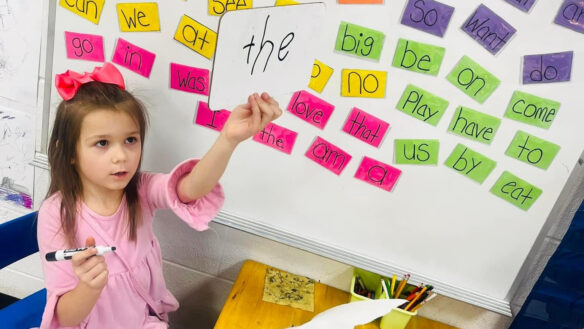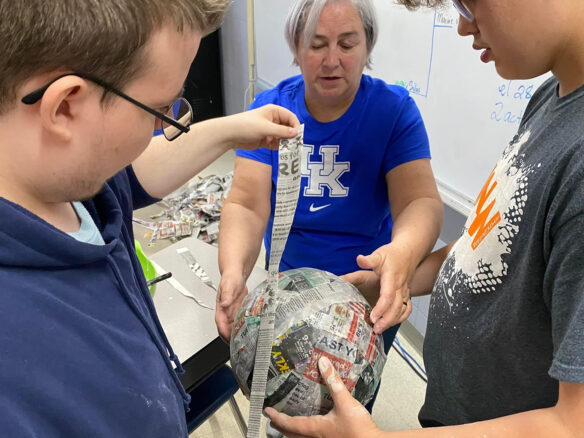
Providing high-quality instructional resources (HQIRs) “are critical for student success,” said Kentucky Commissioner Jason E. Glass.
Photo submitted by Josh DeBorde
When Kelsey Ferguson first started teaching language arts to middle school students at Barbourville Independent, she was given the standards she needed to cover, and she set about creating the units for her 7th- and 8th-grade students.
Using old books from her classroom and lessons she found online, Ferguson tried her best to find resources that matched Kentucky’s academic standards.
“I just kind of put everything together just from any source that I could really find to make my unit, so it was kind of hard,” Ferguson said.
In middle school, language arts instruction involves a lot of preparing students to read deeper into texts and analyze and write texts.
“They grow a lot more than you would think from 7th to 8th grade in their writing,” she said.
A fan of authors like Silas House and Stephen King, Ferguson also wants her students to learn to love reading and create stories they love. So, when she learned that in 2022 the district would be working with teachers to provide a curriculum, it was a relief.
“When I heard we were getting a program that would have everything that we need on it, I was excited,” Ferguson said.
Barbourville Independent was one of nine school districts selected for a two-year pilot program using $2 million in federal American Rescue Plan and Elementary and Secondary School Emergency Relief (ARP ESSER) funds. The funding is to help districts implement high-quality instructional resources aligned with Kentucky’s academic standards and include research-based materials.
ARP ESSER funding supports the safe and sustained return to in-person learning and expands equity by supporting students who need it most, particularly those most impacted by the COVID-19 pandemic.
High-quality instructional resources are defined explicitly by KDE as materials that are aligned with Kentucky Academic Standards, research-based and/or externally validated, comprehensive, culturally relevant, free from bias, and accessible to all students.
Kentucky Commissioner of Education Jason E. Glass said these kinds of materials are crucial in the classroom.
“High-quality instructional resources are critical for student success,” he said. “Access to comprehensive, high-quality instructional resources help teachers adapt lessons to meet the diverse needs of students and to focus their time, energy and creativity on bringing lessons to life and engaging students with the content.”
Micki Ray, chief academic officer at the Kentucky Department of Education, said giving teachers high-quality instructional resources is crucial to improving their instruction and supplementing the unfinished learning facing students across the Commonwealth.
“It allows the teacher to have more time to really consider the art,” she said, “This helps educators in the delivery of that instruction and how better to meet individual student needs because they’re not having to use all of their time just to go out and search for something that they think might be of high quality.”

Students in Barbourville Independent were able to improve their test scores thanks to the implementation of high-quality instructional resources in the district.
Photo submitted by Josh De Borde
Through sessions with ANet, a nonprofit consulting firm hired to help facilitate purchasing a curriculum, teachers from different English language arts grade levels in Barbourville had conversations with administrators and each other on what was working and what they wanted to see in a new curriculum. The nonprofit also helped train teachers on their new curriculum after it was chosen. ANet has gone on to help implement high-quality instructional resources in other Kentucky districts for math and science, as well.
Barbourville Independent ultimately landed on using StudySync from McGraw-Hill, a curriculum aligned with Kentucky’s academic standards that uses scaffolding learning and standards tracking with digital resources. The curriculum was among a list of several options that teachers in the district listed as one of their top choices.
Joshua De Borde, chief academic officer for Barbourville Independent, recalled the positive experience teachers had in the district working with ANet and using the new curriculum. The district has seen improved test scores at the classroom and district levels.
De Borde said he is also particularly proud of the district’s inclusion of all stakeholders in decision-making.
“The biggest part of the process from my end as the chief academic officer was to ensure we had teacher buy-in immediately. There is nobody more important using the resources, finding the resources, taking those and making it their own personalized resource, than the teachers,” said De Borde. “If the teachers are not involved, you will not be successful.”
De Borde said administrators and the English language arts teachers had honest discussions over what was working, what wasn’t working, and where they see major gaps for students, especially those recovering from COVID-related learning disruptions.
“From the beginning, we aimed to ensure every person in the Barbourville Independent district would have 100% confidence that every resource selected could serve every student.”
Brandon Simpson, a high school English teacher in the district, has found his new high-quality instructional resources helpful and has enhanced his instruction. He does not doubt that his students have become stronger writers because of the curriculum’s implementation.
“I’m 26 years in, so for something to impress me the way StudySync did, it’s not very easy,” Simpson said. “It just enhanced what I was already doing so much; it really fit well with what I was doing.”
Ferguson had previously been teaching her 8th–grade students Edgar Allan Poe’s haunting short story “The Tell-Tale Heart.” But the new instructional resources expanded her students’ understanding and enjoyment of the story as they explored the tone and mood of the narrative. Ferguson was able to dig deeper into the story with her students in ways she could never have without a high-quality instructional resource.
For Barbourville, a tight-knit community that prides itself on providing an outstanding education to students, the program’s improvements to test scores is thrilling. It also emphasized what Ray says the purpose and hope of providing high-quality instructional resources is: promoting students to dig even deeper on their own.
“It’s prompting further investigation, further inquiry, furthering their study on behalf of the students, which I would argue is the reason why we do anything,” Ray said.




Leave A Comment